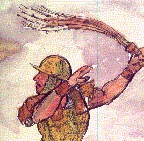Difference between revisions of "Scourge"
m (Text replacement - "http://nordan.daynal.org" to "https://nordan.daynal.org") |
m (Text replacement - "http://" to "https://") |
||
| Line 3: | Line 3: | ||
==Origin== | ==Origin== | ||
[https://nordan.daynal.org/wiki/index.php?title=English#ca._1100-1500_.09THE_MIDDLE_ENGLISH_PERIOD Middle English]: shortening of Old French ''escorge'' (noun), ''escorgier'' (verb), from [[Latin]] ex- ‘thoroughly’ + corrigia ‘thong, whip.’ | [https://nordan.daynal.org/wiki/index.php?title=English#ca._1100-1500_.09THE_MIDDLE_ENGLISH_PERIOD Middle English]: shortening of Old French ''escorge'' (noun), ''escorgier'' (verb), from [[Latin]] ex- ‘thoroughly’ + corrigia ‘thong, whip.’ | ||
| − | *[ | + | *[https://en.wikipedia.org/wiki/13th_century 13th Century] |
==Definitions== | ==Definitions== | ||
*1: whip; especially : one used to inflict [[pain]] or punishment | *1: whip; especially : one used to inflict [[pain]] or punishment | ||
| Line 11: | Line 11: | ||
A '''scourge''' is a whip or lash, especially a multi-thong type, used to inflict severe corporal punishment or self-mortification on the back. | A '''scourge''' is a whip or lash, especially a multi-thong type, used to inflict severe corporal punishment or self-mortification on the back. | ||
| − | The scourge, or flail, and the crook are the two [[symbols]] of [[power]] and [[domination]] depicted in the hands of [ | + | The scourge, or flail, and the crook are the two [[symbols]] of [[power]] and [[domination]] depicted in the hands of [https://en.wikipedia.org/wiki/Osiris Osiris] in Egyptian monuments. They are the unchanging form of the instrument throughout the ages, though one [[interpretation]] of the flail depicted in [https://en.wikipedia.org/wiki/Egyptian_mythology Egyptian mythology] is that it was an agricultural instrument used to thresh wheat, not implement corporal punishment. |
The priests of [https://en.wikipedia.org/wiki/Cybele Cybele] scourged themselves and others. Such stripes were considered [[sacred]]. | The priests of [https://en.wikipedia.org/wiki/Cybele Cybele] scourged themselves and others. Such stripes were considered [[sacred]]. | ||
Latest revision as of 02:29, 13 December 2020
Origin
Middle English: shortening of Old French escorge (noun), escorgier (verb), from Latin ex- ‘thoroughly’ + corrigia ‘thong, whip.’
Definitions
- 1: whip; especially : one used to inflict pain or punishment
- 2: an instrument of punishment or criticism
- 3: a cause of wide or great affliction
Description
A scourge is a whip or lash, especially a multi-thong type, used to inflict severe corporal punishment or self-mortification on the back.
The scourge, or flail, and the crook are the two symbols of power and domination depicted in the hands of Osiris in Egyptian monuments. They are the unchanging form of the instrument throughout the ages, though one interpretation of the flail depicted in Egyptian mythology is that it was an agricultural instrument used to thresh wheat, not implement corporal punishment.
The priests of Cybele scourged themselves and others. Such stripes were considered sacred.
From a Biblical quotation, scorpio "scorpion" is Latin for a Roman flagrum. Hard material was affixed to multiple thongs to give a flesh-tearing "bite". 1 Kings 12:11: "...My father scourged you with whips; I will scourge you with scorpions" said Rehoboam, referring to increased conscription and taxation beyond Solomon's. The name testifies to the pain caused by the arachnid. To its generous Roman application testifies the existence of the Latin words Flagrifer 'carrying a whip' and Flagritriba 'often-lashed slave'.[4] According to the Gospel of John, Pontius Pilate, the Roman governor of Judea, ordered Jesus to be scourged, it being the first step in the traditional Roman punishment for parricide.[1]
